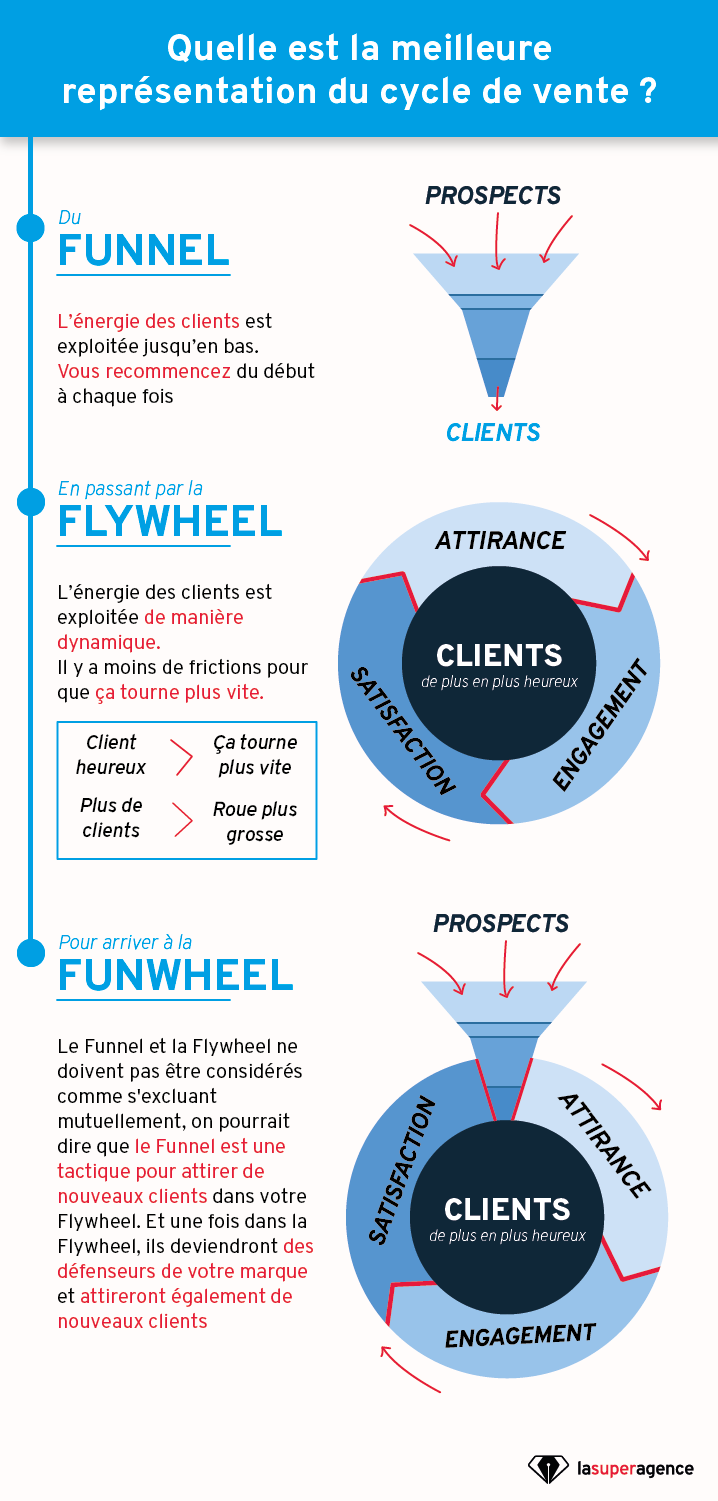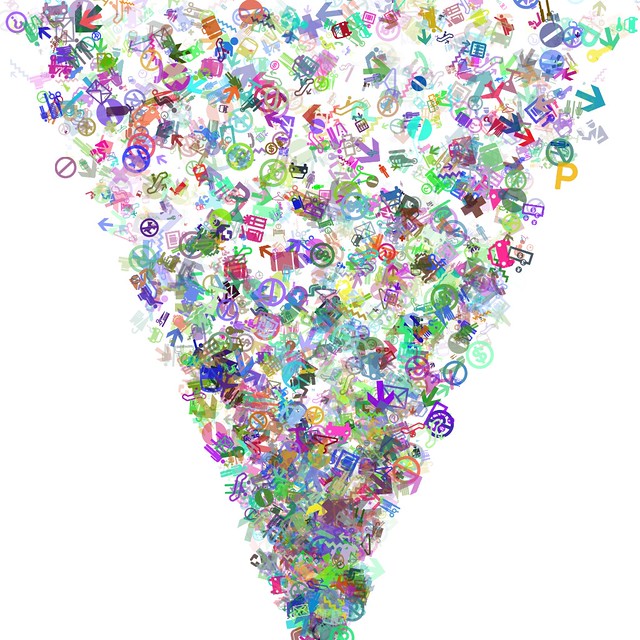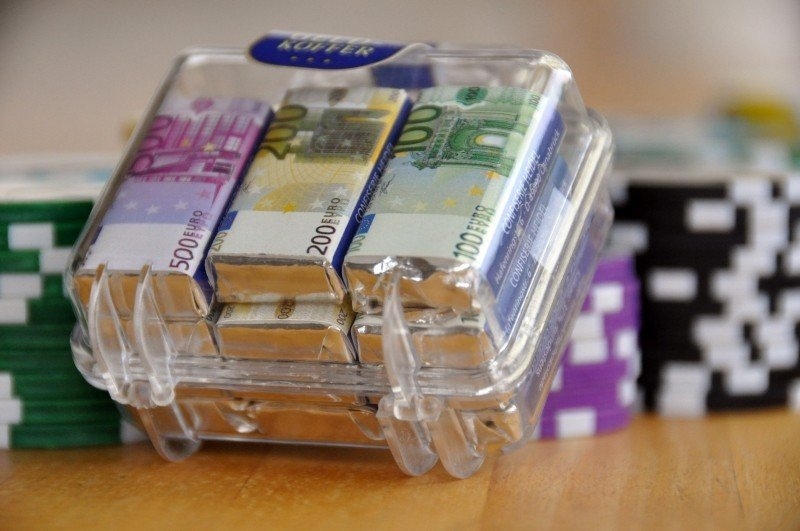Marketers are always trying to find the most accurate representation of the sales cycle in order to better understand it. Funnel, Flywheel, Funwheel, how do you figure it out?
A customer's progression through a sales process is often represented by a sales funnel (also known as a "sales tunnel") that represents a classic buying pattern through which every consumer passes at some point.
However, this representation tends to evolve and the classic funnel diagram is no longer necessarily the most appropriate representation because it does not take into account the impact that already acquired customers can have on new customer acquisition.
 Funnel, Flywheel, Funwheel: the representation of the sales cycle is getting more complex
Funnel, Flywheel, Funwheel: the representation of the sales cycle is getting more complex
1 - The classic funnel representation
The marketing funnel in its simplest form involves generating marketing demand for your product or service at the top of the funnel, by filling it with people (leads).
These prospects then move through the funnel to become qualified leads and (hopefully) customers.
Some people give up along the way, but it's all about getting as many people as possible to the top of the funnel located in order to have the maximum chance of converting them into customers.
With the rise of Inbound Marketing strategies, funnels have become more complex, more strategic, as you follow customers through their purchase journey. The journey breaks down into different stages, with the Inbound marketer providing specific content at each stage.
There may be several stages, but they are generally divided into 3.
The Top of the Funnel or TOFU
The top of the funnel (TOFU) is where you attract visitors to your brand/product/service - usually by driving them to your website and/or a specific landing page. Like any good form of advertising, you provide the content necessary to draw visitors to your website.
Specific TOFU content tools include: social media, SEO, blogging, graphic ads and even more traditional types of advertising, but with a Call To Action on your website.
The Middle of the Funnel or MOFU
This is about converting visitors into leads. You need to convey the importance and value of your brand's product or service.
At this point, you focus on providing much more targeted, high-value type content, such as e-guides, e-books, webinars for visitor data exchange.
Once you have a visitor's data, normally just name and email, you can then put it on un program to lead nurturing usually by email via marketing-automation.
MOFU content tools can be landing pages, downloadable e-guides, eBooks, white papers, webinars or even interactive calculators, especially the ROI type.

Vos prospects parcourent le funnel de conversion
.The Bottom of the Funnel or BOFU
This is the stage where marketing and sales merge. It's now a matter of turning that lead into a prospect and ultimately a paying customer.
Important tools for this stage include personalized and segmented e-mail, lead scoring, scheduled online product demonstrations... and finally picking up the phone and calling to convince the prospective customer directly.
When a prospect has successfully moved through each stage of the funnel, he is now a customer and usually becomes the responsibility of a service/support team. It disconnects from marketing and sales, which is not a good thing.
In fact, your customers are the most powerful and profitable tools for attracting new leads.
2 - The Flywheel : customers at the center of the process
Funnels produce customers, but don't consider how those customers can help you grow and that's where the Flywheel model comes in.
Let's put it in the context of a real-life situation. You have a cold can of motor oil, to get it into your engine, you (aka marketing and sales) pour it into a funnel. Once in the funnel, you lose the oil in your engine (i.e. your business) and it's almost forgotten, but it's still flowing around your engine, helping to make things work.
The Flywheel concept has been championed by Hubspot CEO Brian Halligan as a way for that company to reflect on its business and pay dividends. Here's an excerpt from a great blog post by Hubspot's VP of marketing, Jon Dick:
"Flywheel is a circular process where customers fuel growth. We've invested more in customer marketing, more in customer advocacy, and more in creating a fun onboarding experience for new customers. We've also invested in an ecosystem of integrations that helps customers do more with HubSpot and creates real value for the people who adopt our software suite."
(Jon Dick, Hubspot)
So the customer is at the center of the process:
At its core, the Flywheel is about focusing on building relationships with your customers while the Funnel is more about closing deals.
How is this done?
Marketing: Your marketing team continues to engage existing customers with content that adds value to them and their businesses. This engagement keeps them coming back for additional products and services or to renew their current products.
Sales: thanks to the power of word-of-mouth, your customers have become better marketers than you. You can no longer simply attract new customers only to forget about them in pursuit of the next deal.
Instead, you need to build meaningful relationships and put them at the center of your organization. Love them to death, or at least to advocacy, and make them sell for you.
However, does this Flywheel model neglect the funnel model entirely? Out, is it really fair to not consider the first model?
3 - The winning combination: the Funwheel!
The Funwheel represents the combination of the two concepts of Funnel and Flywheel which, when put together, more clearly and comprehensively describe the sales cycle.
While the funnel remains relevant to attract new customers (aiming very broadly at first to capture prospects and then moving them along in the process to become a customer), one cannot overlook the Flywheel which helps create a lasting dynamic with customers already acquired.
Thus, the combination of these two models is the most accurate in representing sales cycles.

The Funwheel: attracting then satisfying the customer to make them a brand ambassador
Marketing funnels are not dead, they are still part of a solid marketing strategy and you will still need them for a level of customer acquisition.
The big difference is the ability to use the funnel to fill the Flywheel. Now, these customers are not simply transferred to the carrier once the funnel is filled.
In contrast, the energy invested in acquiring customers already acquired to surrect satisfaction, attraction and commitment to one's brand in order to entice new customers and convert your old buyers back into new customers.
This allows you to better focus on their journey as customers, not one-time prospects.
Funnel and Flywheel should not be considered mutually exclusive, you could say that the funnel is a tactic to attract new customers into your Flywheel.... which then becomes a Funwheel!
And once in the driver's seat, your customers will become your best brand ambassadors and attract new customers as well.
In conclusion, representations of the sales cycle are evolving just as marketers are devising new strategies to acquire new customers. So we must remain open and not take patterns for granted.







